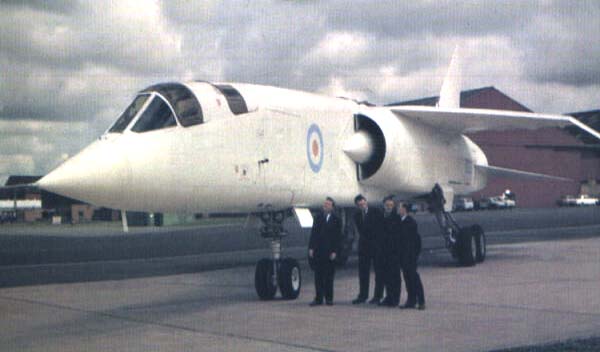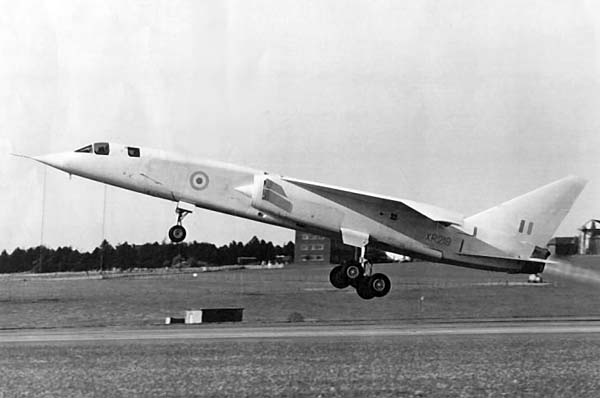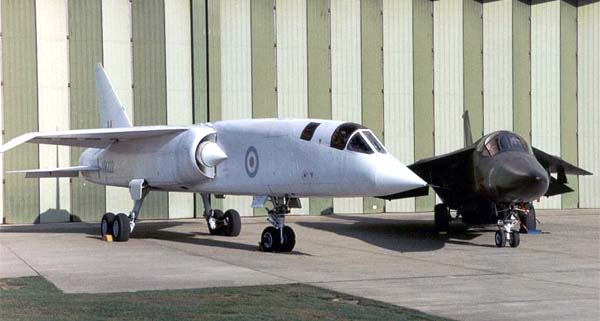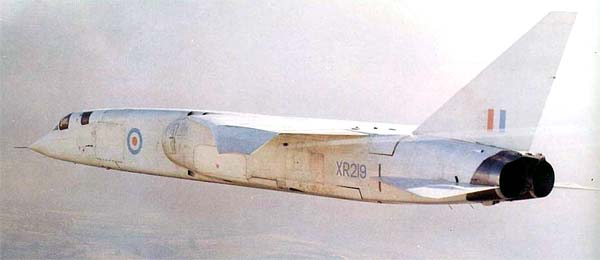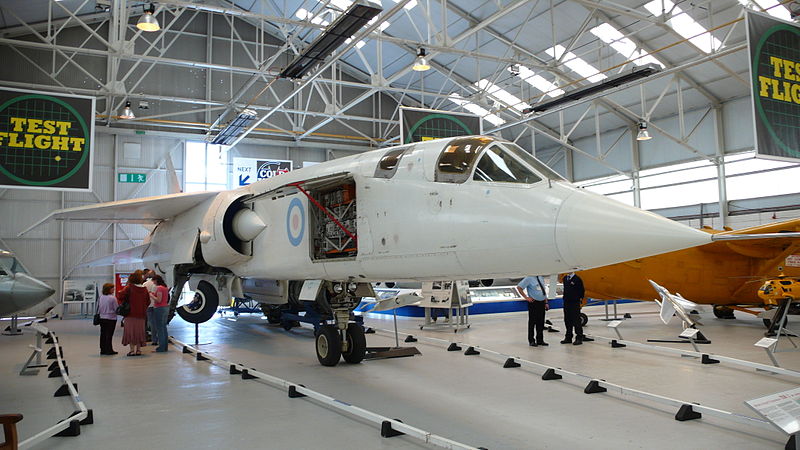بسم الله الرحمن الرحيم
الطائرة BAC TSR2 XR220
TSR.2, Cosford
Production Details
Design Company:
British Aircraft Corporation Ltd
First Flight:
27 September 1964
TSR.2:
1 - BAC (several other aircraft almost finished when project cancelled)
Type Specification
Applies to:
BAC TSR.2
Type:
Long-range, high and low level all-weather bomber to specification GOR.339
Wing:
High-wing cantilever monoplane. Swept delta wing with down-turned tips. All metal construction
Fuselage:
Long, slim, all-metal fuselage
Tail Unit:
Tailerons mounted mid-height on fuselage. All moving fin. All have swept leading edges
Landing Gear:
Retractable tricycle undercarriage. Nose gear has side by side wheels which retract rearwards into fuselage. Main gear has two wheels in line which retract forward into fuselage
Power Plant:
Two 30,600 lb st with reheat Bristol Olympus turbojet engines mounted in the fuselage
Accommodation:
Crew of two in tanden enclosed cockpits in forward fuselage. Pilot in front, navigator/weapons officer in rear
Armament:
Internal bomb-bay with addition pylons under wing carrying various combinations of bombs and missiles
Dimensions
Span:
37 ft 1.7 in
Length:
89 ft 0.5 in
Height:
23 ft 9 in
Wing Area:
702.9 sq ft
Weights
Empty:
54,750 lb
Normal Take-off:
102,200 lb
Performance
Max Speed:
Mach 2.0 plus at altitude
Ferry Range:
3,000 plus miles
Preserved in British Museums
TSR.2:
XR220 - Royal Air Force Museum, Cosford Airfield - Display
XR222 - Imperial War Museum, Duxford - Display
Unknown - Brooklands Museum, Brooklands - Nose
Production Details
Design Company:
British Aircraft Corporation Ltd
First Flight:
27 September 1964
TSR.2:
1 - BAC (several other aircraft almost finished when project cancelled)
Type Specification
Applies to:
BAC TSR.2
Type:
Long-range, high and low level all-weather bomber to specification GOR.339
Wing:
High-wing cantilever monoplane. Swept delta wing with down-turned tips. All metal construction
Fuselage:
Long, slim, all-metal fuselage
Tail Unit:
Tailerons mounted mid-height on fuselage. All moving fin. All have swept leading edges
Landing Gear:
Retractable tricycle undercarriage. Nose gear has side by side wheels which retract rearwards into fuselage. Main gear has two wheels in line which retract forward into fuselage
Power Plant:
Two 30,600 lb st with reheat Bristol Olympus turbojet engines mounted in the fuselage
Accommodation:
Crew of two in tanden enclosed cockpits in forward fuselage. Pilot in front, navigator/weapons officer in rear
Armament:
Internal bomb-bay with addition pylons under wing carrying various combinations of bombs and missiles
Dimensions
Span:
37 ft 1.7 in
Length:
89 ft 0.5 in
Height:
23 ft 9 in
Wing Area:
702.9 sq ft
Weights
Empty:
54,750 lb
Normal Take-off:
102,200 lb
Performance
Max Speed:
Mach 2.0 plus at altitude
Ferry Range:
3,000 plus miles
Preserved in British Museums
TSR.2:
XR220 - Royal Air Force Museum, Cosford Airfield - Display
XR222 - Imperial War Museum, Duxford - Display
Unknown - Brooklands Museum, Brooklands - Nose

قمرة القيادة

الاجنحة
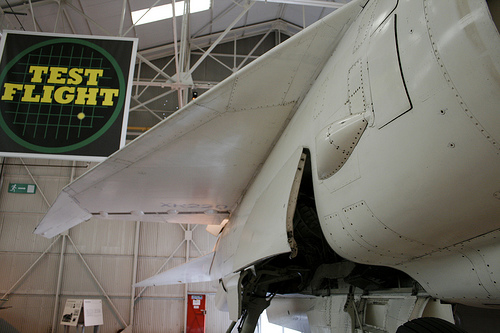
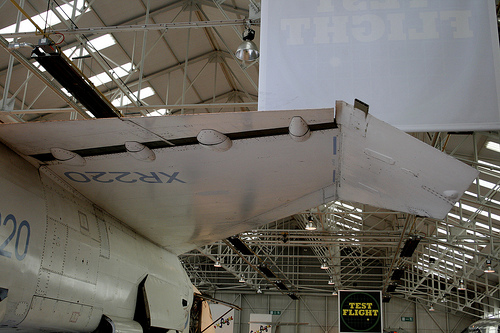
العجلات
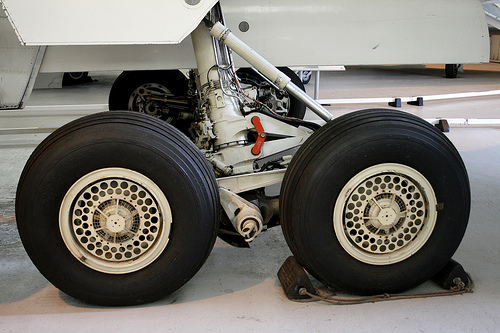
المحرك
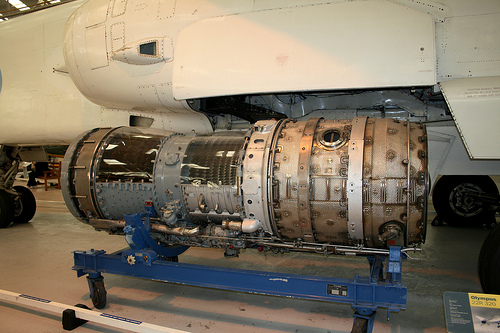
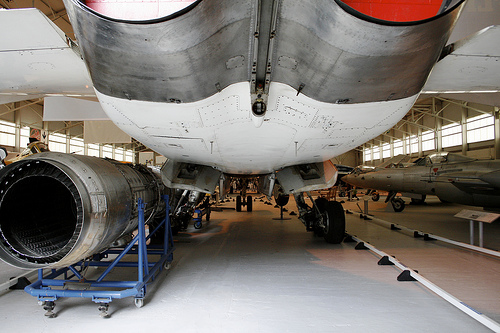
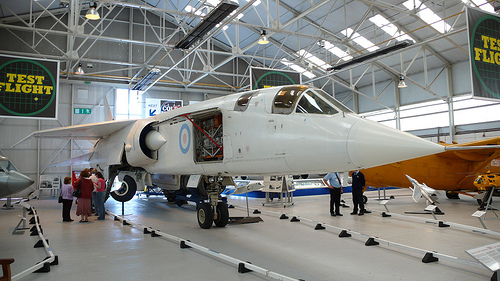
الشكل الكلى



In 1957, to replace the RAF's Canberra jet bomber, a super sonic tactical strike & reconnaisance aircraft development was started.
At the time it was designed to be capable of far advanced specifications, such as maximum speed of mach 2.75 and low altitude super sonic crusing with nuclear warheads, long range of 1850km without refueling, STOL from a rough surface runway, advanced rador systems.
the aircraft was called TSR-2.
The TSR-2 made her maiden flight succesfully with Bristol Olympus 22R jet engines on 7th. September 1964.
Initial test flights showed the aircraft's great performance. However, the new Labour goverment did not like its awfully expensive development costs, and axed the project in April 1965.
Instead of the beautiful TSR-2, the RAF was promised to be equipped with 55 of American F111s. But this was also cancelled, and at the end, alas, they finished up with NAVY's un-atractive Buccaneers.
It saved some money for the Labour goverment's budget, but ruined the capability of the British aircraft industry to develop a super sonic aircraft on thier own to date.
Specifications;
Span : 11.28m (37ft)
Length : 27.13m (89ft)
Max speed : over mach 2
Engine : 2 x Bristol Olympus


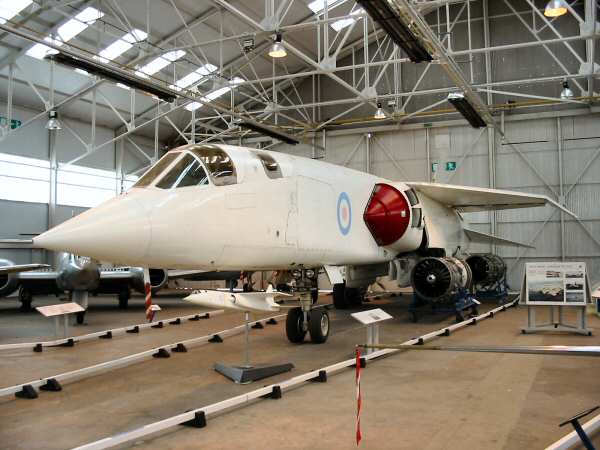


فيديو للطائرة
http://www.youtube.com/watch?v=a7JAYHHsVU8&feature=related
معلومات وافية عن الطائرة

BAC TSR.2 XR220 in flight, artists impression
There are a number of aircraft that remain interesting not for what they accomplished, but for what they might if they hadn't died in infancy. Sometimes these aircraft even acquire the status of cults. One of the most appealing of these "cult" machines is the British Aerospace Corporation (BAC) "TSR.2", an elegant and advanced British strike aircraft of the early 1960s. This document provides a short history of the TSR.2.
BAC TSR.2 Origins
By the early 1950s, the English Electric Canberra bomber and reconnaissance aircraft had become one of the mainstays of the British Royal Air Force (RAF). Although the Canberra was an excellent aircraft, and in fact is still performing useful, if limited, military service in the 21st century, by the middle of the 1950s it was obviously behind the times.
The Air Staff began to cast around for a replacement in 1956, leading to the issue of "General Operational Requirement 339 (GOR.339)" in March 1957. GOR.339 was a very ambitious specification, dictating a machine that could operate at high or low level at high speed in any kind of weather, with long range, and a heavy payload of tactical nuclear weapons and advanced reconnaissance systems. It was to have good short-field performance, and operate from unimproved forward airfields.
A skeptic might have suspected that such a "gold-plated" machine might lead to troubles in the contemporary British political environment. On 4 April 1957, just after issue of the original GOR.339 requirement, British Defense Minister Duncan Sandys (pronounced "Sands") issued a famous defense white paper that proclaimed the era of manned combat aircraft was drawing to a close. Missiles were the way of the future, and of course government weapons procurement plans would reflect that reality.
Sandys remains the target of much wrath and abuse by British air enthusiasts, who tend to be dedicated lot, though as a mitigating factor he wasn't alone in his views at the time, with similar attitudes also leading to an overly optimistic embrace of missile technology in both the US and the USSR. The facts still remain that the "Sandystorm", as the incident became known, had a strong and very negative impact on the British aviation industry, and that manned combat aircraft are still alive and thriving in the 21st century.
Furthermore, the failure of OPERATION MUSKETEER, the Anglo-French-Israeli invasion of Egypt in 1956 that foundered on opposition from the US and the USSR, indicated that the days of Britain's imperial ambitions were over for good. There was a clear need to downsize the UK's aviation industry, but instead of a soft landing the end result, as will be shown here, was a crash that strewed wreckage across the landscape.
In any case, all manned combat aircraft programs were on uncertain ground, and the ground under the GOR.339 effort was particularly shaky. What complicated matters for the RAF was that the Royal Navy was also working on a strike aircraft, the Blackburn "NA.39", which would become the "Buccaneer". There was obvious sense in the RAF and the Royal Navy acquiring a common strike aircraft, but the NA.39 was subsonic, and the RAF regarded anything less than Mach 2 performance as unsatisfactory.
The NA.39 was regarded, with good reason, as a threat to the GOR.339 program, and RAF officials compiled long lists of reasons why the Blackburn machine wouldn't fit their needs, much to the irritation of their Royal Navy counterparts. When Blackburn proposed a supersonic derivative of the NA.39 that would better fit RAF needs, the company found reception of the idea very frosty. As one RAF official put it: "If we show the slightest interest in NA.39, we might not get the GOR.339 aircraft."
For the moment, GOR.339 moved ahead. A deadline of 31 January 1958 had been set for manufacturers to submit proposals, and all major British aircraft builders, then still a fairly large set, did so. A wild range of designs was submitted, with the British Air Ministry sorting through the proposals to finally pick out two that seemed the most promising: the English Electric "P.17A" and the Supermarine "571". At the time, Supermarine was a branch of the Vickers-Armstrong conglomerate. The English Electric P.17A was regarded as the front-runner, but the Supermarine 571 was a very close second, and Air Ministry officials were highly impressed with how Vickers-Armstrong had embraced the "total weapons system" concept, in which the designers considered not only the aircraft but all the support facilities needed to operate it.
One of the other complicating factors in the GOR.339 competition was the fact that the British government was strongly encouraging British aviation firms to merge. Given this mindset, it made a certain amount of sense for the Air Ministry to combine the two designs and have both companies collaborate on the hybrid, which was defined in a new specification designated "Operational Requirement 343 (OR 343)". Such a move also invited a certain amount of chaos and confusion into the development process. In any case, on 1 January 1959 the Air Staff publicly gave the green light for development of the aircraft, which was given the formal designation "Tactical Strike & Reconnaissance 2 (TSR.2)".
The collaboration between English Electric and Vickers-Armstrong on the TSR.2 was a step towards the larger goal of consolidating the British aircraft industry. This goal was essentially realized in January 1960 with the formation of the "British Aircraft Corporation (BAC)", which was initially a merger of English Electric, Vickers-Armstrong, and Bristol Aircraft. Hunting Aircraft joined in September 1960.
Following preliminary design contracts, BAC was awarded a full development contract for 90 million pounds on 7 October 1960, covering delivery of nine development aircraft. An order for 11 operational TSR.2s was tacked onto the contract later, for a total of 20 aircraft.
TSR.2 description
The aircraft that emerged from the design process was a long, sleek machine, with certain resemblances to, and clear influence from, the pioneering North American A-5 Vigilante carrier-based bomber and strike aircraft, then going into service with the US Navy.
GVG/PD
 The BAC TSR-2 silhoutte, shown with 2 x Martel ASM & drop tanks
The BAC TSR-2 silhoutte, shown with 2 x Martel ASM & drop tanksThe TSR.2 was a big aircraft, over 6 meters (20 feet) longer than an Avro Lancaster bomber and about twice as heavy. The aircraft featured pilot and navigator seated in tandem under clamshell canopies; a high-mounted swept wing; a conventional tail assembly; and twin Bristol Siddeley Olympus 22R Mark 320 afterburning turbojets. The TSR.2 was built largely of conventional aluminum-copper aviation alloys, though more exotic metals, such as aluminum-lithium and titanium alloys, were used selectively where needed.
The inlets for the engines were on the sides of the aircraft, forward of and underneath the top-mounted wing, and were of semicircular shape, with a moveable half-cone shock diffuser. The Olympus engine had already been in service on the Avro Vulcan bomber, but the 320-22R version was to be fitted with an afterburner and other improvements. The engines were expected in maturity to provide 146.8 kN (14,970 kgp / 33,000 lbf) afterburning thrust each.
The aircraft's wing had 60 degree sweepback on the leading edge and was straight across the trailing edge. It was of relatively small area to give a smooth ride at Mach 1.2 at sea level, though such high wing loading also necessarily limited maneuverability. The wing had neither dihedral nor anhedral, but did have turned-down wingtips for roll stability. One of the interesting features of the wing was that its spars were connected to the fuselage through two-pin pivoting links that allowed the wings to flex in flight; this measure not only made for a smoother ride, but increased the airframe life by reducing vibration. The tail assembly featured all-moving tailplanes, set at a dihedral and with small auxiliary elevators, and an all-moving tailfin.
Although the Americans were interested in "variable geometry" or "swing wings" that could pivot outward to give a high-performance aircraft good low-speed and landing capabilities, the TSR.2 instead used a "blown flaps" scheme, in which engine bleed air was fed through the back of the wing and blown over wide-span trailing edge flaps to lower the stall speed and takeoff run. Takeoff run with a typical warload was expected to be about 490 meters (1,600 feet).
A large brake chute, stored in a "pen-nib" fairing between the engine exhausts, helped reduce landing roll. There were four large airbrakes, arranged in a distinctive "flattened X" pattern on the fuselage between wing and tail, with the upper airbrakes staggered a short distance behind the lower airbrakes. The landing gear was long enough to allow the airbrakes to be deployed during landings.
BAC TSR.2CountryUnited Kingdom
 Wingspan11.28 meters37 feetWing area65.03 sq meters700 sq feetLength27.13 meters89 feetHeight7.32 meters24 feetEmpty weight20,300 kilograms44,900 poundsMTO weight43,500 kilograms96,000 poundsMax speedMach 2.25Service ceiling16,500 meters54,000 feetOperational Radius1,850 kilometers1,150 milesCrewPilot & NavigatorEngine typeOlympus 320-22RNo. of Engines2
Wingspan11.28 meters37 feetWing area65.03 sq meters700 sq feetLength27.13 meters89 feetHeight7.32 meters24 feetEmpty weight20,300 kilograms44,900 poundsMTO weight43,500 kilograms96,000 poundsMax speedMach 2.25Service ceiling16,500 meters54,000 feetOperational Radius1,850 kilometers1,150 milesCrewPilot & NavigatorEngine typeOlympus 320-22RNo. of Engines2
The wing was built as an integral fuel tank, though since it was thin it didn't have much capacity, particularly in comparison to the large fuel tanks fitted into the fuselage. A Lucas-built fuel system automatically maintained fuel trim. An inflight-refueling probe retracted into the left side of the nose.
RWK
 The TSR.2 featured heavy duty landing gear for rough field operation
The TSR.2 featured heavy duty landing gear for rough field operationAnother particularly interesting feature of the TSR.2 was the landing gear, which was designed to meet the requirement for rough-field operation and was appropriately "industrial strength". The steerable, backward-retracting nose gear featured twin tires, and could jack itself up to give the aircraft a "nose-up" attitude and so help reduce take-off distance. The main landing gear featured large twin wheels, arranged in tandem on each assembly. The wheels were all fitted with low-pressure tubeless tires for operation on dirt airstrips. The tall stance of the landing gear gave the TSR.2 a birdlike appearance on the ground, an impression enhanced by the forward retraction of the main landing gear in flight.
Flight controls were driven by redundant hydraulics, activated mostly by mechanical linkages, though the TSR.2 did feature some electrically-activated controls. The control system was laid out with care to ensure that it would not be crippled by a single lucky hit during combat.
The TSR.2 did not have any built-in armament. It would be able to carry up to 2,720 kilograms (6,000 pounds) of conventional or nuclear munitions in its internal bombbay, and could also be fitted with four underwing pylons to carry a total external load of 1,815 kilograms (4,000 pounds).
In a strategic nuclear strike mission, the TSR.2 would carry a single "Red Beard" strategic nuclear weapon in its bombbay. The Red Beard would be delivered in a "toss bombing" attack, in which the aircraft would release the bomb in a climb and fly away on afterburner before weapon detonation. In a tactical nuclear strike mission, the TSR.2 would carry a total of four "WE.177" tactical nuclear weapons, with two in the bombbay and two on underwing pylons, laid down in level strike using retarding parachutes.
In a conventional strike mission, the TSR.2 could be loaded down with high-explosive bombs and unguided rocket pods, and carriage of the TV-guided "AJ.168 Martel" missile was considered. Fuel tanks could be fitted on the stores pylons, while a ferry tank could be carried in the bombbay, and semi-conformal belly drop tank was planned as well. A TSR.2 could also carry a "buddy refueling" pack to refuel one of its mates for a deep-penetration mission or ferry flight.
RWK
 BAC TSR-2 XR220 at RAF Cosford air Museum
BAC TSR-2 XR220 at RAF Cosford air MuseumThe TSR.2 was to feature a navigation-attack system as or more sophisticated than any other in the world. The autopilot system was derived from the US Autonetics Verdan, used on the Vigilante, substantially improved by Elliot Flight Automation of the UK to adapt it for low-level operations. It was programmed by paper tape, punched by keyboard and then read into the system before a mission. The autopilot acquired navigation data from multiple inputs, including a Ferranti inertial navigation system; a Decca Doppler radio navigation system; a Smiths air data system; a Ferranti solid-state forward-looking monopulse radar that tracked and provided imagery of the terrain; and twin Standard Telephones & Cables radar altimeters to provide height data.
The TSR.2 could guide itself to a target in almost any weather, day or night, with the pilot observing progress and all relevant mission data on a Rank-Cintel head-up display (HUD) that projected the flight data directly on the windscreen. The aircraft would be able to automatically sense obstructions such as radio towers and fly around them. If there was a system failure, the TSR.2 would automatically climb to give the pilot time to take full manual control.
The cockpit's windscreen was hardened against high-speed birdstrikes, always a problem in low-level operations, and was covered with a gold film to protect against nuclear flash. The pilot and navigator rode in Martin-Baker Mark 8A ejection seats, which not only had "zero-zero (zero speed, zero altitude)" capability, but were qualified for ejections at Mach 2 and 17,070 meters (56,000 feet). The navigator could eject on his own, leaving the pilot behind, or the pilot could eject both crewmen, the navigator leaving the aircraft an instant before the pilot to avoid collision.
Along with the nav-attack system and sensors, other avionics kit included a long-range Marconi HF radio; a short-range Plessy UHF/VHF radio; a Corsor identification friend or foe (IFF) unit; and a Marconi instrument landing system (ILS). Oddly, no defensive countermeasures suite was defined for the TSR.2, though it may have been done and kept a secret.
The sophisticated avionics kit of the TSR.2 would have made it a very sophisticated aircraft, but at a price. The obvious difficulty was that so much new technology might take more time than scheduled to get right. That could be accepted, but there was a subtler difficulty: with so few manned aircraft in development in the UK, that meant that the cost of work on new avionics for the TSR.2 could not be spread over multiple aircraft development programs, as it would have been in the US.
The TSR.2 was fitted with a forward looking film camera in the nose and an oblique film camera on each side of the forward fuselage. In bombing missions, the camera imagery would be used for strike assessment, and of course the cameras could also support reconnaissance missions. However, the primary reconnaissance system was to be provided by a sensor pallet plugged into the weapons bay. This was to be fitted with an EMI "side-looking airborne radar (SLAR)" and a Hawker Siddeley Dynamics / Mullard infrared linescan day-night thermal imager.
The EMI SLAR shot pulses out to the sides of the aircraft and recorded the echoes on a film strip to produce a "map" of the terrain under the TSR.2's flight track. The SLAR had a "moving target indicator (MTI)" capability that highlighted moving objects on the film strip. It appears that the SLAR, whose antennas were permanently mounted in the forward fuselage, could operate in a much more limited capacity without the pallet as a navigation aid for strike missions, obtaining a terrain map about every 160 kilometers (100 miles) or so as a check for the navigation system.
The linescan would have been able to transmit imagery in real-time to a ground station, and a daylight TV camera sensor with a similar capability was considered. A conventional film-reconnaissance pack was also planned.
As mentioned, the TSR.2 was designed in accordance with the "weapons system" concept, with all details considered for operations from rough forward airstrips. The aircraft was fitted with an auxiliary power unit (APU) for self-starting and ground power. BAC designed a comprehensive ground-servicing system, including:
- A "ground system vehicle (GSV)" that could tow the aircraft on the ground, while providing systems to power the aircraft during servicing and pump fuel from flexible storage bags.
- A self-powered "heavylift trolley" that could be used to lift or remove stores or systems to or from the aircraft and provide a service platform capable of reaching any part of the aircraft. Although care had been taken to provide plenty of service doors in the aircraft and make them accessible, the tall landing gear kept the machine high off the ground and demanded a servicing platform.
- A "universal testing trolley" that was towed by the GSV and could perform functional tests on the aircraft's systems.
BAC TSR.2 Flight and Fall
The progress of the TSR.2 program was politically rocky. There were factions in the British government that were opposed to it, and friction with the Royal Navy over the Buccaneer "alternative" to the TSR.2 continued. The political problems were aggravated by the fact that initial funding estimates had been, in hindsight, recklessly low for such a complicated machine, guaranteeing cost overruns and unwanted public attention. Opposition Labour Party politicians began to snipe at the project as an example of the waste and inefficiency of the government in power, while Conservative politicians responded with a muddled and unpersuasive defense. It appears that the controversy became extremely bitter, with the bitterness lingering to the present day.
There was also the fact that the TSR.2 really was a complicated machine, with advanced elements and systems that kept a good part of Britain's high-tech industries busy. That would have been a challenge under the best circumstances, but the creation of BAC from a number of companies that had been formerly rivals led to an extreme level of confusion and bureaucracy. The bureaucracy was compounded by the fact that since there were few other British military aircraft programs in progress at the time, Air Ministry officials were able to give the TSR.2 effort an unusually high and often counterproductive amount of attention, with every detail put through discussion in endless meetings.
It is somewhat surprising that the development of the machine went as well as it did. The worst technical problems were with engine development. The first flight-worthy Olympus 320-22R was fitted to the belly of an Avro Vulcan bomber in a very large housing with split twin inlets, with flight tests beginning in February 1962. The Olympus 320-22R was so powerful that it could keep the Vulcan flying without use of the bomber's own four engines. In fact, the engine was probably too powerful, pushing the state of the art, a consequence of the severe specification that the TSR.2 had to be able to maintain Mach 2.2 for 45 minutes. The engine exploded on the ground on 3 December 1963, destroying the Vulcan, as well as a fire truck that didn't stay out of harm's way. There were two more major engine failures over the next six months.
The engine problems were tracked down and the engine modified, but TSR.2 prototype construction had gone forward with unmodified engines. Nobody wanted to add more delays to the program to wait for new engines, and so the initial prototype performed its first flight, bogus engines and all, on 27 September 1964, with Wing Commander Roland P. "Bea" Beamont at the controls and navigator Don Bowen in the back seat.
Beamont was instructed to keep the engines under 97% RPM to avoid an engine failure, and the short flight was conducted with gear down. The chase plane crew was alarmed to see the TSR.2 trailing white streaks from the wingtips, thinking it was a fuel leak, but it turned out to be no more than condensation vortexes. The flight was essentially a publicity stunt to show critics progress on the program. Beamont insisted that the prototype be fitted with proper engines before he took it into the air again. Test pilots accept taking risks, but playing Russian roulette was just not on.
The new engines were fitted and the TSR.2 performed its second flight on 31 December 1964. 22 more test flights were conducted to the end of March, for a total of 24. Beamont and other flight test crew found the aircraft very impressive, with excellent handling and blazing performance right over the treetops, though it was not fitted with anything resembling the operational avionics kit. A number of problems were encountered and resolved. There remained major problems with the landing gear design, which caused serious vibration that rattled the aircrew and threatened loss of control on touchdown, but that issue was being addressed.
That was as far as it got. On 6 April 1965, British Prime Minister Harold Wilson's Labour government announced the cancellation of the TSR.2 program, making the day one of the most dismal in all British aviation history. The TSR.2 had completed only about 13 hours of flight tests. Another TSR.2 prototype was to fly the same day as the cancellation but never left the ground, and most of the rest of the initial batch of nine prototypes were in various stages of completion.
The project was dismantled with what has been described as "indecent haste", with almost everything burned, scrapped, or discarded. The single flying prototype met a humiliating end, being gradually blown to pieces over a period of years as a ground gunnery target hulk, while most of the other prototypes in various stages of assembly were scrapped. The only saving grace of the whole sad situation was that two prototypes were rescued, with one now on display at the Aerospace Museum in Cosford, and the other on display at the Imperial War Museum in Duxford.
The RAF settled on the US General Dynamics F-111K as a replacement, leading to a follow-on fiasco when the F-111 ran into development problems and severe cost escalation. The British government cancelled that order in turn, and the RAF finally, wearily, with an irony lost on no one, turned to the Blackburn Buccaneer as a solution. In reality, the RAF would find the Buccaneer to be an outstanding aircraft that provided excellent service into the Gulf War in 1991. Had the RAF the benefit of hindsight, they might have saved themselves a lot of trouble. However, it is hard not to be sympathetic to the regrets of British air enthusiasts over the TSR.2's passing.
التعديل الأخير:

